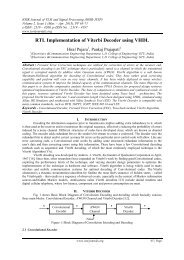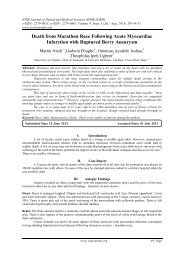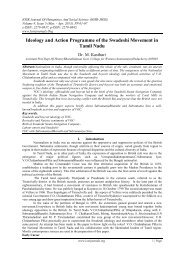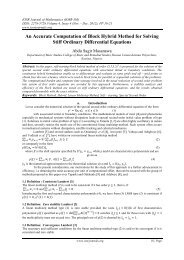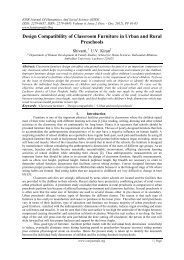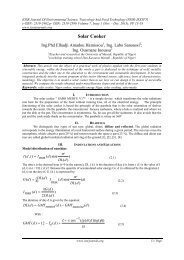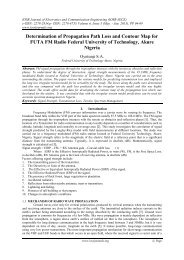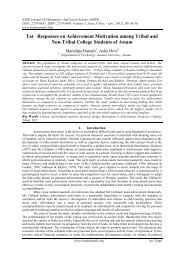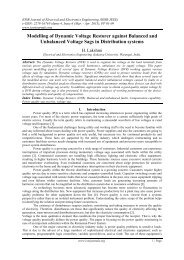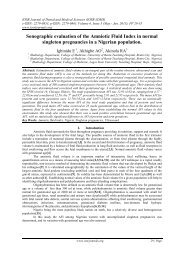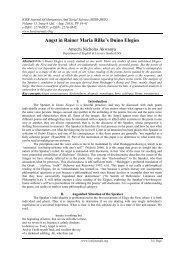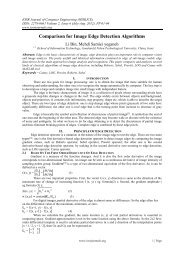Initial Conquest of India by Turks and Their Slaves - IOSR
Initial Conquest of India by Turks and Their Slaves - IOSR
Initial Conquest of India by Turks and Their Slaves - IOSR
You also want an ePaper? Increase the reach of your titles
YUMPU automatically turns print PDFs into web optimized ePapers that Google loves.
<strong>Initial</strong> <strong>Conquest</strong> Of <strong>India</strong> By <strong>Turks</strong> And <strong>Their</strong> <strong>Slaves</strong><br />
Comm<strong>and</strong>er <strong>of</strong> Faithful), Giyath-ud-Din engaged in a duel for Khurasan with the Khwarizmshahs, in which,<br />
prior to his death in 599/1203 the Ghurids definitely had the better <strong>of</strong> it. Muizz-ud-Din, who like Giyath-ud-Din<br />
bore the title <strong>of</strong> Sultan, ably seconded his bother‟s efforts; but he also looked eastwards.<br />
The Ghurid conquest <strong>of</strong> Hind was initiated from Ghazna. Having defeated the Ghuzz at Ghazna in<br />
1173, Giyath-ud-Din had placed the city in the charge <strong>of</strong> his younger brother Muizz-ud-Din, the future<br />
„Conqueror <strong>of</strong> Hind‟ (Khursau-i-hindgir); who „ascended the throne <strong>of</strong> Ghazna like Mahmud‟. One difference<br />
was that Muizz-ud-Din received Ghazana as a family appanage. Once installed at Ghazna, Muizz-ud-Din was<br />
not slow to appropriate the Ghaznawids role as the st<strong>and</strong>ard bearer <strong>of</strong> orthodox Islam in the subcontinent. He<br />
made war on the Ismāilis in Multan <strong>and</strong> captured the city in (571/1175-6) <strong>and</strong> then captured Daybul in Indus<br />
Delta in 578/1182-3. Certainly he is praised for his warfare against the Shiis. The annexation <strong>of</strong> the remaining<br />
Ghaznawid territories was undoubtedly his principal goal. A series <strong>of</strong> campaigns from 577/1181-2 onwards<br />
secured first tribute from Khusraw Malik <strong>and</strong> then,in 582/1186, the capitulation <strong>of</strong> Lahore. Khusraw Malik was<br />
sent to Giyath-ud-Din <strong>and</strong> later put to death in captivity.The beginning <strong>of</strong> Turkish ascendency over the Islamic<br />
world was contemporaneous with the emergence <strong>of</strong> a new fighting order is <strong>India</strong>n society. The Arab had to face<br />
Brahmin dynasty in Sindh, the <strong>Turks</strong> faced the Rajput. After the end <strong>of</strong> Harsha‟s empire in 7th Century saw a<br />
new aristocracy taking gradual shape. This was the „Rajput‟ (not encountered in the Muslim sources before the<br />
sixteenth century) who for the next few centuries championed a resuscitated Brahmanism <strong>and</strong> controlled the<br />
destiny <strong>of</strong> North <strong>India</strong>. He had points <strong>of</strong> resemblance with the Turk. To both, the sword was the means <strong>of</strong><br />
achieving glory; philosophical speculation held no attraction for either <strong>of</strong> them; clannishness <strong>and</strong> a blind loyalty<br />
characterized the two peoples; a kind <strong>of</strong> feudalism featured both the political systems. But the Rajput excelled<br />
the <strong>Turks</strong> in reckless bravery <strong>and</strong> a chivalrous sense <strong>of</strong> honor that led him to commit self-destruction rather than<br />
suffer defeat or go down in his own estimation.<br />
The Arabs had faced an effete people in Sind, to the <strong>Turks</strong> was opposed this virile warrior race who<br />
ruled the country from the Siwalikh to the Vindhyas. But the Rajput thirst for military glory proved his nemesis,<br />
for it led to constant wars <strong>and</strong> to political disintegration. The Gurjara-Pratihara Empire had given a way to a<br />
multi-state system in which a ceaseless struggle for lord – paramountcy was the order <strong>of</strong> the day. Twelfth<br />
century <strong>India</strong> was indeed, a tempting prize for the l<strong>and</strong> hungry <strong>Turks</strong>.<br />
The nature had provided a narrow entrance to the Ganges valley (a belt <strong>of</strong> l<strong>and</strong> not exceeding three<br />
hundred miles in breadth <strong>and</strong> skirted <strong>by</strong> the forbidding Himalayas <strong>and</strong> central <strong>India</strong> wilderness on either side)<br />
which is not difficult to guard. The Aravalli hills from the southwest <strong>and</strong> the Siwalikh (Sapadalaksha) from the<br />
north-east approach each other across the plain separating the Punjab from the Ganges valley, leaving a<br />
conveniently narrow gap not more than a hundred miles in width. Through this gap, or to use a commoner term<br />
bottleneck, alone, the Ganges valley or to use the name given <strong>by</strong> the Muslims, Hindustan could be approached<br />
militarily from the west. The ordinary route from beyond the Sulaiman mountains in those days was not the<br />
well-known Khaiber pass, nor the Bolan in the south, but through the Gomal, which led to Dera Ismail Khan<br />
<strong>and</strong> thence to upper Sind Sagar Doab. The Khaiber, Bolan <strong>and</strong> the less accessible Kurram <strong>and</strong> Tochi passes<br />
were not used <strong>by</strong> trading caravans to the same extent as the Gomal passage which was the normal military route.<br />
Throughout the 13th Century the first point <strong>of</strong> attack for an invading army from beyond the Sulaiman<br />
range was Multan or Uch <strong>and</strong> not Lahore or Peshawar. From Ghazni the shortest route to Punjab was through<br />
the Kurram, Tochi <strong>and</strong> Gomal Passes <strong>and</strong> Khaiber involved a long detour through the north. Politically the<br />
Khaiber area was not safe.The tribes inhabiting the northern Sind Sagar Doab were perpetually hostile. His<br />
(Muizz-ud-din) earliest incursion into the Dār al-Harb had ended in disaster. Passing through Multan <strong>and</strong> Uchh<br />
in 1178/574, he struck across the Rajputana desert <strong>and</strong> arrived with an exhausted army at the foot <strong>of</strong> Mt. Abu<br />
where he found the fresh troops <strong>of</strong> Mularaja II waiting to oppose his progress. In the engagement, fought near<br />
hill <strong>of</strong> Kayadra. In an opposition which was not <strong>of</strong> Muizz-ud-din‟s choosing he suffered a signal defeat. It was<br />
the defeat not only <strong>of</strong> his forces but also <strong>of</strong> his plans. For him Hindustan now appeared to have only one<br />
practicable approach <strong>and</strong> the annexation <strong>of</strong> the Ghaznawid Punjab became more a strategic than a political<br />
necessity. The next few years accordingly found him making a determined <strong>and</strong> gradual advance through<br />
Khusrau Malik‟s dominion. Peshawar was taken in 1179; Sialkot fell in 1185, <strong>and</strong> Lahore, after three<br />
expeditions was finally occupied in 1186, <strong>and</strong> with his own governor installed at Lahore, he now found himself<br />
in possession <strong>of</strong> the Indus basin <strong>and</strong> in a strategic position to advance further into the fertile plains <strong>of</strong> <strong>India</strong>. His<br />
was only the most successful <strong>of</strong> the many attempts made <strong>by</strong> the <strong>Turks</strong> from the northwest to obtain a foothold in<br />
Hindustan all <strong>of</strong> which may therefore be regarded as preliminaries to Tarian. Muizz-ud-din brought to<br />
successful end a century <strong>of</strong> reconnoitering activity, a programme <strong>of</strong> military action <strong>of</strong> which he was not the<br />
conqueror. On these occassions the Muslim invaders were repeatedly repulsed.<br />
The Chauhanas who ruled the territory extending from Ajmer to Delhi <strong>and</strong> thus guarded the entrance<br />
into Hindustan felt pressure <strong>of</strong> Muslim invasions. Durlava II <strong>of</strong> Sambher is said to have lost his life in fighting<br />
the <strong>Turks</strong>, Ajayadeva is credited with having repeatedly defeated the Muslim intruders. In the reign <strong>of</strong><br />
Vigraharaja IV they advanced on Balbera (modern Rupnagar in Kishangarh). The Delhi pillar inscription <strong>of</strong> this<br />
www.iosrjournals.org<br />
4 | Page



